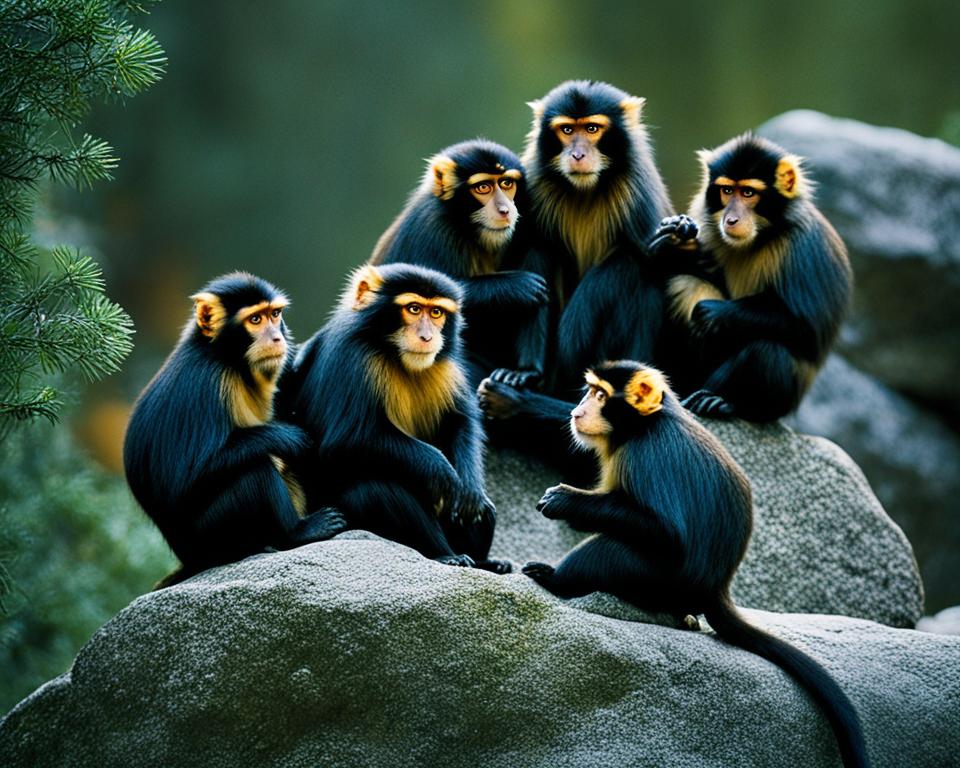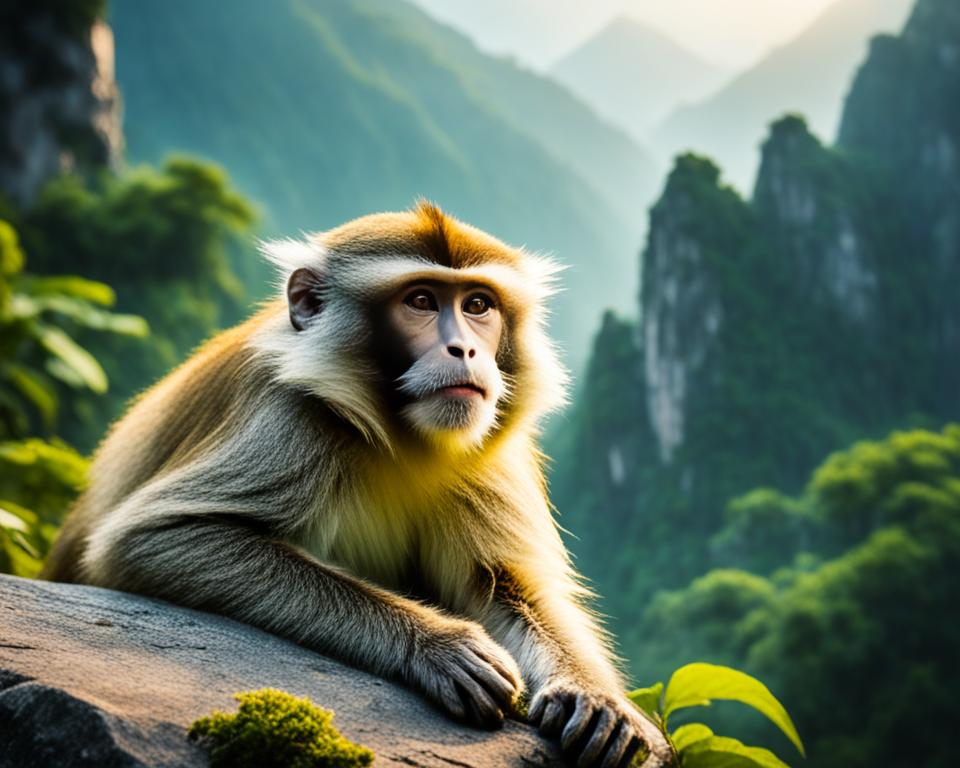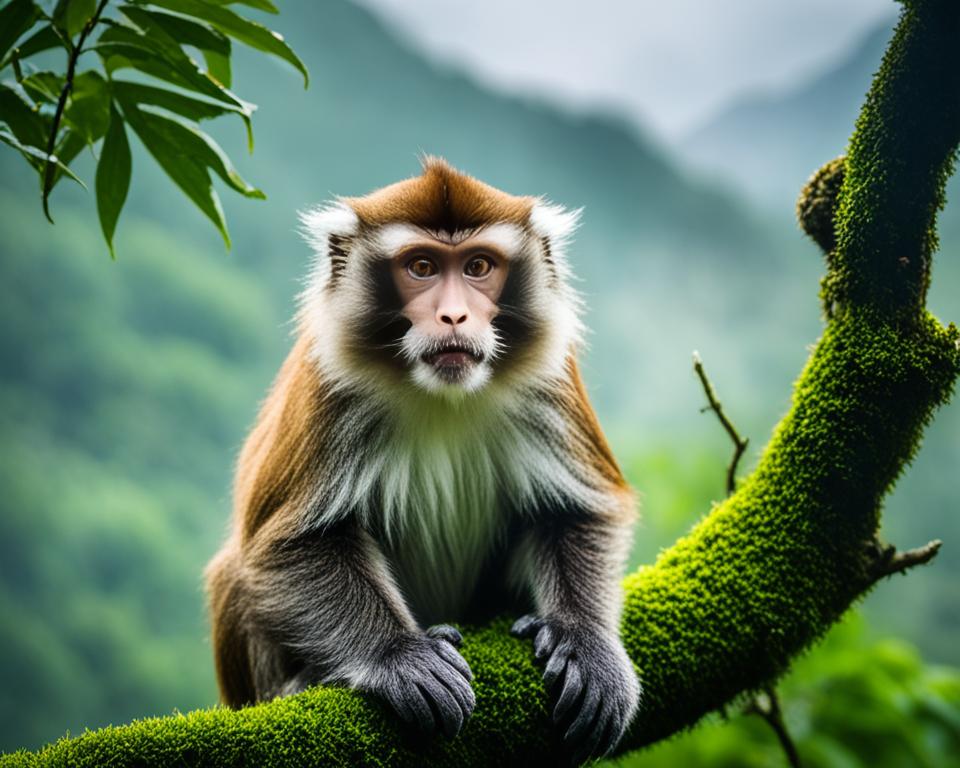The Chinese mountain monkey is also called the golden snub-nosed monkey or Sichuan golden hair monkey. It is a rare and endangered primate species. It lives in the mountainous regions of central and southwestern China.
This unique arboreal primate has golden fur and an upturned nose. It’s known for its social behavior and bamboo-based diet. We’ll explore the world of this Chinese endemic, talking about its looks, home, food, friends, and efforts to help it survive.
Read more interesting information at ::lesdamesmiami
Introduction to the Captivating Chinese Mountain Monkey
The Chinese mountain monkey is a special endemic primate species. It lives only in the mountainous regions of China. What makes them stand out are their golden-brown fur and upturned nose. This look is both noticeable and cute.
Endemic Primate Species of China’s Mountainous Regions
Considered a endemic species, the Chinese mountain monkey thrives in China’s tough mountain climates. They have a key role in these places. This shows how they’ve adapted well to survive in this unique environment.
Distinctive Physical Characteristics
The Chinese mountain monkey stands out because of its looks. A golden-brown fur covers its body. But it’s the upturned nose that really catches your eye. These features make it uniquely charming among monkeys.
Endangered Status and Conservation Efforts
Right now, the Chinese mountain monkey is in danger. It faces problems like habitat loss and poaching. To save this extraordinary species, important conservation efforts are happening. Their survival is crucial for a balanced ecosystem.
The Golden Snub-Nosed Monkey: A Unique Species
The golden snub-nosed monkey is a special kind of monkey from China. It has a beautiful golden-brown coat and a cute, upturned nose. These features make it stand out and look unique and adorable.
Striking Appearance with an Upturned Nose
What makes the golden snub-nosed monkey unique? Well, it’s its upturned nose and golden-brown fur. This special nose and fur combination makes it memorable and loved by those who see it.
Arboreal Lifestyle in Bamboo Forests
The golden snub-nosed monkey lives high up in the bamboo forests of China. It is especially good at climbing trees. This monkey feeds on bamboo, which is a big part of its diet.
Sichuan Golden Hair Monkey: A Rare Sight
The Sichuan golden hair monkey is a rare and elusive subspecies of the Chinese mountain monkey. It’s found in the remote Sichuan province mountain ranges in southwestern China. Even fewer than the broader Chinese mountain monkey species, spotting the Sichuan golden hair monkey is rare. This makes it a prized find for researchers and wildlife fans.
There are only a few hundred Sichuan golden hair monkeys left in the wild. This fact makes them one of the rarest primates on Earth. Their home in the mountains is hard to reach, and they face dangers like habitat loss. Such issues put them at a critical risk.
Seeing a Sichuan golden hair monkey is an unforgettable experience. Their golden-brown fur and unique looks make them stand out in China’s remote mountains. Because sightings are so rare, it highlights the need to protect them. Urgent conservation work is required to keep this special monkey safe.
Chinese Mountain Monkey: Habitat and Distribution
The Chinese mountain monkey lives in the mountains of central and southwest China. It is also called the golden snub-nosed monkey. Their home includes the high lands of Shaanxi, Gansu, Sichuan, and Chongqing.
Mountainous Regions of Central and Southwest China
The Chinese mountain monkey is uniquely suited to its mountain homes. These areas feature high peaks, deep forests, and a rich mix of plants and animals. The monkeys excel at climbing steep terrains and find their food among the abundant bamboo and plants.
Adaptation to High-Altitude Living
Living in high peaks has led the Chinese mountain monkey to unique adaptations. These include a thick fur coat for warmth and energy-saving activities during rough weather. They are well-evolved for their mountain lifestyles.
Bamboo Diet and Foraging Behavior
The Chinese mountain monkey loves to eat bamboo in its mountainous home. Its special tummy helps it digest the tough, woody bamboo plants. This way, they get all the nutrients needed from their main food source.
Specialized Digestive System for Bamboo Consumption
The Chinese mountain monkey has a digestive system perfect for a bamboo diet. Their stomach is big, and the microbes in their gut help break down the bamboo. This lets them live well in high places with lots of bamboo, unlike most other primates.
Seasonal Variations in Diet
The diet of the Chinese mountain monkey changes with the seasons. When bamboo is plenty, they pick from a variety of types. Yet, they also eat leaves, flowers, and fruits when bamboo is less available. This flexibility is crucial for dealing with food changes in their mountain home.
| Bamboo Species | Nutritional Value | Seasonal Availability |
|---|---|---|
| Fargesia spp. | High in cellulose and lignin, providing essential fiber | Year-round, with peak availability in summer |
| Bashania fangiana | Rich in carbohydrates and vitamins, particularly during new growth | Spring and early summer |
| Yushania spp. | Higher protein content compared to other bamboo species | Autumn and winter, when other bamboo resources are scarce |
Social Structure and Group Dynamics
The Chinese mountain monkey lives in groups with clear leaderst. Typically, a big male leads. These monkeys have a social hierarchy, which guides how they interact and behave.
Hierarchical Social Groups
The Chinese mountain monkey follows a strict pecking order. This order is based on age, size, and who’s in charge. This system helps keep the group stable. Each monkey knows its place and job in the hierarchy.
Complex Communication and Interaction
These monkeys are pros in communication. They talk using sounds, facial expressions, and body language. This helps keep the peace, organize activities, and stay close. They’ve got it all figured out.

Threats and Conservation Challenges
The Chinese mountain monkey is unique to China’s mountains and faces big threats. These threats put their future at risk. A big problem is losing their homes due to deforestation, people moving in, and new buildings in their mountain areas.
The monkeys also face danger from being hunted and sold illegally. People want them because they look interesting and they think they can help with illness. This illegal trade hurts their already small numbers.
Climate change is making things worse for the monkeys. Big storms, dry spells, and floods can destroy where they live. This disrupts their food and whole living spaces. Over time, the changing climate will make these dangers even greater. The monkeys’ survival is in big trouble.
To protect the Chinese mountain monkey, we need a big plan. This plan should deal with many issues like protecting their homes, stopping illegal trade, and helping them through climate changes. We also need to work with the people living there and across the world.
Chinese Mountain Monkey: Research and Study Efforts
Significant efforts aim to grasp the Chinese mountain monkey‘s biology, behavior, and how they fit into their ecosystem. Scientists observe these primates in their wild homes. They learn about what the monkeys eat, how they interact, and where they move.
Field Observations and Data Collection
Fieldwork is key to understanding the Chinese mountain monkey. By watching their daily life, researchers can piece together their social groups, find out what they eat, and how they cope with high altitudes.
Genetic Studies and Population Monitoring
Besides watching them in the wild, genetic studies help us learn the Chinese mountain monkey‘s history. This knowledge is essential for protecting the species. Scientists also keep tabs on their number and distribution to see if our conservation efforts are working.
| Research Approach | Key Findings | Implications for Conservation |
|---|---|---|
| Field Observations | Detailed data on feeding habits, social behavior, and movement patterns of Chinese mountain monkeys | Informs habitat management, population monitoring, and conservation strategies |
| Genetic Studies | Insights into evolutionary history and population structure of the species | Guides captive breeding programs and reintroduction efforts to maintain genetic diversity |
| Population Monitoring | Tracking population trends and evaluating the effectiveness of conservation interventions | Enables adaptive management and targeted conservation actions to protect the species |
The Role of Ecotourism and Conservation Awareness
Ecotourism and conservation education are key for saving the Chinese mountain monkey. These efforts help by bringing in money for conservation and by teaching people about the monkey’s struggles. Also, education campaigns and community programs play a big part. They help local and global folks understand and love these monkeys.
Responsible Wildlife Tourism
Responsible tourism that lets people see the Chinese mountain monkey in its home can do a lot of good. It helps fund conservation efforts. But, it’s crucial this kind of wildlife tourism doesn’t harm the monkeys or their homes. Ensuring it’s a win for the monkeys and the locals.
Public Education and Community Engagement
Teaching the public and getting communities involved are critical. These efforts unite locals and the world in loving the Chinese mountain monkey. They also make a lasting positive impact. Through teamwork, those dedicated to conservation can join forces with communities. Together, they craft smart plans to protect the monkey’s future.

Cultural Significance and Folklore
The Chinese mountain monkey is very important in China. People see it as a symbol of certain cultural and spiritual ideas. These monkeys are in a lot of traditional art, stories, and myths. They show up in many parts of Chinese culture, making people interested in them.
Symbolic Representation in Chinese Culture
The Chinese mountain monkey is a special symbol in China. It stands for long life, wisdom, and luck in Chinese traditions. Its unique look, with golden-brown hair and a special nose, is often shown in Chinese art. You can find images of it in paintings, statues, and other artworks.
Myths and Legends Surrounding the Primates
The Chinese mountain monkey is also at the center of many myths and tales in Chinese culture. These stories tell of the monkey’s magical powers, like being able to talk to mountain spirits. They also say the monkey brings good luck to people. These tales have made the Chinese mountain monkey even more important in Chinese culture. They fascinate everyone and add to the monkey’s special status.
Future Prospects and Conservation Strategies
The Chinese mountain monkey, also called the golden snub-nosed monkey, faces many challenges. To save this rare primate, we need a strong plan. The main goals include protecting its home, boosting its numbers, and helping it survive in the wild again.
Habitat Protection and Restoration
Keeping the monkey’s mountain homes safe is key. We should make special areas where they can live without harm. It’s also important to stop illegal hunting and work with locals to use the land wisely. Adding more plants and fixing damaged forests help make their homes better and healthier.
Captive Breeding and Reintroduction Programs
Helping the monkey through captive breeding is crucial. It keeps a healthy group of monkeys ready to go back to the wild. Working with the locals, we can release them in places they used to live. This plan helps grow their populations and mix up their genes.
International Collaboration and Funding
Many hands from around the world are needed to protect the monkey. Groups working together can come up with good ideas and share what works. Money from different places will keep these projects going. It also supports the people who study and check how well the monkeys are doing.
Conclusion
The Chinese mountain monkey is a special primate, living only in China’s mountains. It is in danger because of a few key issues, like loss of homes, poaching, and climate change. However, people are working hard to save it.
Efforts to save the monkey focus on protecting its mountain homes. This includes promoting eco-friendly tourism and getting local people involved in conservation. The goal is to keep this important primate alive for future generations to enjoy.
There’s hope for the Chinese mountain monkey’s survival. A global effort is underway to tackle the threats it faces. With everyone working together, we can make sure these unique animals keep thriving in the wild.



